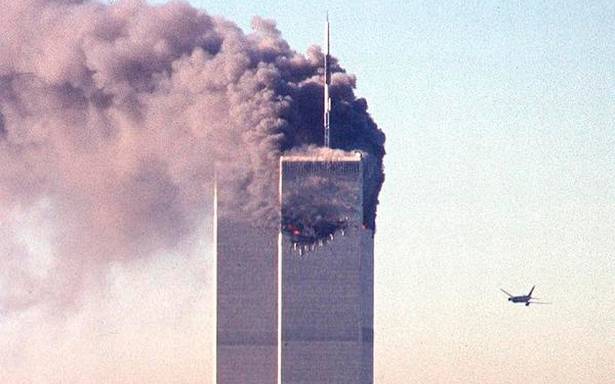Instead of one centralised outfit like in 2001, the world now has many al-Qaedas
“Our war on terror begins with al-Qaeda, but it does not end there,” former U.S. President George W. Bush said days after the September 11, 2001 terrorist attacks. “It will not end until every terrorist group of global reach has been found, stopped and defeated,” he told the U.S. Congress.
Afghanistan was the first outpost in what the Bush administration called a “global war on terror”. The U.S. invaded Afghanistan to get rid of the Taliban regime, which refused to hand over 9/11 mastermind Osama bin Laden, and defeat al-Qaeda. Twenty years later, the U.S. exited a Taliban-controlled Afghanistan with al-Qaeda networks spread across many countries.
War on al-Qaeda
When the 9/11 attack was planned and executed, al-Qaeda had a permanent base in the Taliban-ruled Afghanistan. The U.S. invasion toppled the Taliban regime and killed many al-Qaeda terrorists and disrupted their network in Afghanistan. It was the heaviest blow to al-Qaeda, which had carried out multiple bombings in the past targeting the U.S., including the Embassy bombings in Kenya and Tanzania in 1998 and the attack on USS Cole off Aden, Yemen, in 2000.
But al-Qaeda would find an opportunity to regroup and rebuild its organisation in Iraq after the 2003 American invasion. Abu Musab al-Zarqawi, the Jordan-born al-Qaeda leader, established al-Qaeda in Iraq (AQI), capitalising on the chaos Iraq fell into after the invasion. Zarqawi also exploited the resentment among Iraq’s Sunni community towards the political changes in Baghdad (Shias, the country’s oppressed majority under Saddam Hussein’s rule, rose to power after the invasion) and launched a sectarian civil war.
So within a few years of the U.S.’s Afghan invasion, al-Qaeda found a new haven in post-Saddam Iraq.
The rise of IS
Zarqawi was killed in 2006 and AQI suffered setbacks as Iraqi Sunnis, backed by U.S. forces and the central government, formed local militias to take on the terrorists. This calmed Iraq, but it did not last long. When Arab regimes were rocked by protests in 2011, jihadists found a new opportunity amidst the chaos that followed. In Syria, regional rivals of President Bashar al-Assad and their allies, including the U.S., offered support to different rebel groups, pulling the country into a deadly civil war. Abu Bakr al-Baghdadi, who was the leader of the Islamic State of Iraq, the new avatar of AQI, sent a group of his militants under the command of Abu Mohammad al-Joulani across the border to Syria. Joulani would set up a new al-Qaeda branch in Syria — Jabhat al-Nusra — which declared war on President Assad’s government.
Nusra’s brutal tactics and Islamist vigour helped the group capture territories in the chaotic, multi-directional Syrian civil war. An ambitious Baghdadi announced the Islamic State of Iraq and Syria (ISIS), involving his group in Iraq and al-Nusra in Syria. Joulani, who was backed by the al-Qaeda core led by Ayman al- Zawahiri, bin Laden’s successor, fell out with Baghdadi. But the faction of the Nusra that backed Baghdadi’s call for an Islamic State joined his new outfit, which would emerge as the most ferocious jihadist group from the Syrian civil war, capturing territories from Syria’s Raqqa to Iraq’s Mosul and Falluja, practically erasing the border between the two countries.
For a few years, the IS would reign as the world’s most dangerous terrorist outfit, but it would be defeated by concerted attempts by several players, including Kurdish and Shia militias and the U.S., Syria. Iraq, Iran and Russia.
Metastasised threat
If al-Qaeda was concentrated in Afghanistan before September 11, they decentralised themselves and spread to different parts of the world during the course of the war on terror. The IS did the same when its ‘Caliphate’ came under attack in Iraq and Syria. It opened new provinces in other war-torn countries such as Afghanistan, where the civil war was going on, and Libya, which fell into chaos after the NATO invasion of 2011. Boko Haram, a jihadist group that came up in Nigeria, declared its loyalty to the IS, allowing the group to expand its operations in Africa.
Baghdadi is dead, but the man he sent to Syria to open a local branch of al-Qaeda, Abu Mohammad al-Joulani, is now the de facto ruler of Idlib, the province that stays outside the control of Mr. Assad’s government. Al-Qaeda has different operational branches now such as al-Qaeda of the Arabian Peninsula and al-Qaeda in the Islamic Maghreb. In Africa, both al-Qaeda and the Islamic State (IS Greater Sahara and IS West Africa Province) have set up units, which have carried out brutal attacks in recent years, especially in the Sahel region. In Somalia, al-Shabab still remains strong.
When the U.S. withdrew from Afghanistan, its first outpost in the war on terror, after 20 years of fighting, the terror threat, as President Joe Biden said, has “metastasized across the world”. Instead of one centralised outfit with a base, the world now has many al-Qaedas.
Source: Read Full Article

